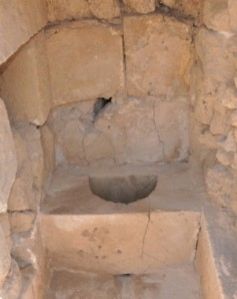Ancient Toilet Still Contains Crusaders’ Feces, Shows Parasites Plagued 12th Century Castle Residents [PHOTOS]


An ancient toilet in Cyprus filled with 800-year-old feces has shed light on an ailment that plagued Crusaders, according to two researchers from the University of Cambridge. Testing samples of dried-up poop from the latrine located in a medieval castle, the pair discovered that they contained parasitic eggs.
The castle, Saranda Kolones, was built sometime after King Richard I of England captured the Mediterranean island in 1191, during the Third Crusade. The castle was used for roughly 30 years before being destroyed by an earthquake in 1222. Most of the fortress was destroyed by the 7.0 magnitude earthquake, but the latrines on the lower floors survived, Live Science reports.
The researchers rehydrated the human waste and strained it using a sieve to catch the patristic eggs that the Crusaders digested in their meals. The samples showed lemon-shaped eggs belonging to type of giant roundworm and whipworm eggs, the Smithsonian Magazine reports.
The study was published in the International Journal of Paleopathology. Piers D. Mitchell, one of the study’s authors, says the findings show how noblemen and clergy from the Third Crusade were just as likely to die from malnutrition and disease as in battle.
"In these circumstances [it] is quite likely that medieval soldiers with a heavy parasite load would have been at increased risk of death from starvation during famine episodes such as long sieges or expeditions when supplies ran out," the researchers wrote. "This is because they would have had to share the limited available food with their parasites."
The parasites that were found can cause an infection known as trichuriasis. According to the U.S. Centers for Disease Control, those infected with parasitic worms can be asymptomatic or suffer from bloody stools. Infections are caused by ingesting the eggs, which happens when hands or fingers have contaminated dirt on them or by eating vegetables or fruits that have not been properly washed.
According to researchers, mature female roundworms start to lay about 200,000 eggs per day. With whipworms, mature females release 2,000 to 10,000 eggs a day. In modern times, both are the most common and widespread intestinal parasites – the giant roundworm infests an estimated one-sixth of all humans.
But this are not the oldest parasites ever found. Roundworms, whipworms and tapeworms that were 10,000 years old were found in Neolithic sites of Khirokitia and Shillourokambos in Cyprus.
© Copyright IBTimes 2024. All rights reserved.






















